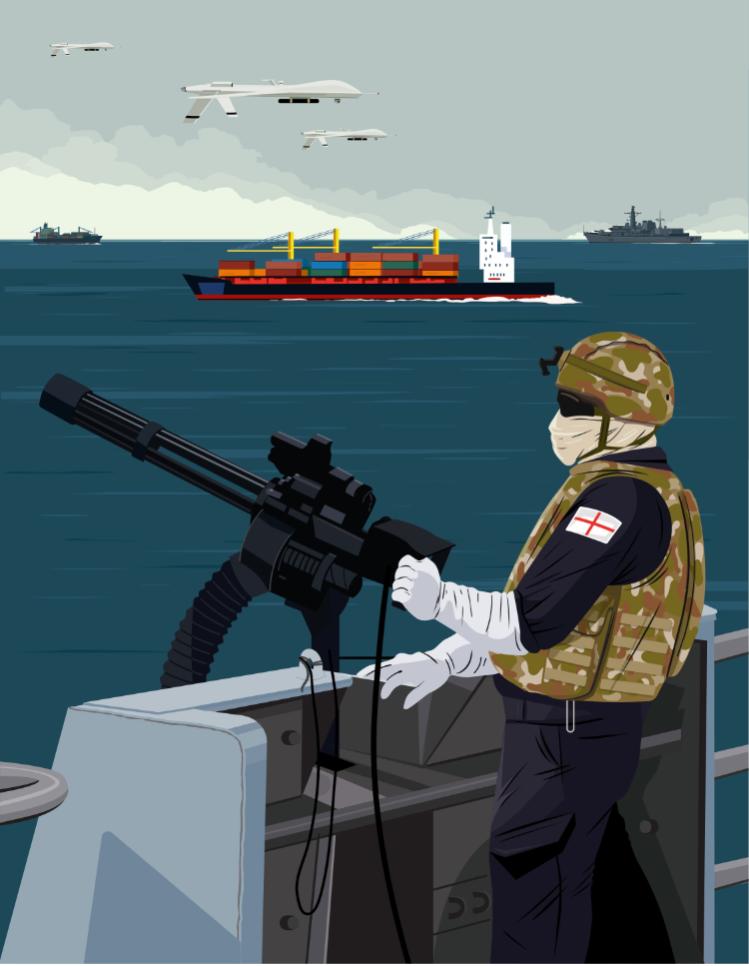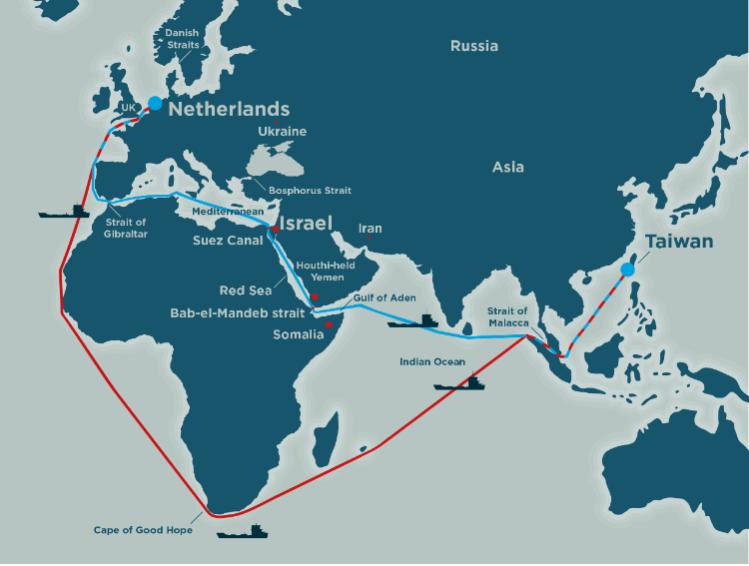Current affairs: how maritime trade can survive our changing world
Illustration: Tracy Worrall
7 min read
The Red Sea crisis underlines maritime trade’s vulnerabilities. Sophie Church reports how complex global supply chains are adapting to an increasingly uncertain maritime world. Illustrations by Tracy Worrall
In October, the Hamas-supporting Houthi rebels in Yemen began attacking Israeli ships in the Red Sea, threatening to continue until Israel ends its blockade of Gaza and agrees to a ceasefire. The attacks soon spread to British and American shipping. And, following retaliatory airstrikes from the United States and the United Kingdom, The House exclusively revealed in January that a British aircraft carrier is ready to be deployed to the region.
This crisis is playing out in one of the globe’s nine maritime trade ‘choke points’: the Bab el-Mandeb Strait which, ironically, means the ‘Gate of Grief’. The strait lies at the southern end of the Red Sea, between the coast of Houthi-held Yemen and the Horn of Africa.
Over the past two months, passages through the Suez Canal, which links the Red Sea to the Mediterranean, have reduced by around 42 per cent, with cargo ships forced to redirect – at great time and expense – around South Africa’s Cape of Good Hope.
I find it absolutely bizarre the way they keep ducking and weaving from spending on defence, which is so crucial for the security of our nation
This is compounded by Somali pirates hijacking at least four ships since November 2023, causing further disruption to trade through the Gulf of Aden and the Indian Ocean.
For all humanity’s technological advancements, these events have reasserted how critical the sea is for facilitating global trade. So, as we enter a new age of geopolitical instability, will supply chain disruptions like these force us to rethink our reliance on the sea?
To understand the current impact of the Red Sea crisis, picture the global shipping system as a taxi rank, suggests Chris Rogers, head of supply chain research at S&P Global Market Intelligence.
As taxis are forced to take more circuitous routes, more people are left queuing at the rank. Effectively, the longer vessels are at sea, the less capacity there is in the system.
“Our estimates are this is equivalent to reducing the capacity of the global container fleet by around 10 per cent,” he says. Shipping rates have trebled as a consequence.
The damage to different supply chain players is dependent on the cargo. Those cargo owners that are shipping lower-value items that take up more space – for instance, furniture – will be feeling the effects of these longer journeys more than others, says Simon Heaney, senior manager for container research at maritime research agency Drewry.
“The increase in freight rates you’re going to feel more, because on a per unit basis the increase is much higher,” he says. “It’s going to affect different sectors, depending on the value of goods and the quantity of goods that they can squeeze into containers.”
 Illustration: Tracy Worrall
Illustration: Tracy Worrall
Agricultural exporters in southern European countries will be particularly affected by the Red Sea bombardment, with their fresh produce gradually wilting on the longer journey around the Cape of Good Hope. Italian exports of apples to Saudi Arabia and the United Arab Emirates, valued at around €400m a year, have now been halted – the value left unrealised.
But according to a monthly survey issued by S&P Global, purchasing managers in the UK are suffering more than their international partners from longer supplier delivery times.
For UK purchasing managers, “the increase in shipping times is a lot more than for those in the Eurozone”, Rogers says. “I think that shows the UK being affected or at least saying it’s being affected more quickly.”
Supply lines have faced disruptions through individual choke points before. Elsewhere, the Strait of Hormuz, Strait of Malacca, Strait of Gibraltar, the Bosphorus Strait, the Danish Straits and Cape of Good Hope remain operational.
However, the Panama Canal is facing its own climate-induced crisis, with low water levels reducing traffic by 40 per cent compared to last year. “We’ve never seen anything like this,” Heaney says. “We’ve had closures of Suez before. But you’ve never had Panama and Suez both at the same time in trouble.”
Despite these challenges, Heaney says supply lines have faced worse. “Those ships that were ordered during the pandemic are being delivered,” he says. “There is much more slack in the system from having excess supply of ships… In the pandemic, you had warehousing issues, you had labour issues in ports, you had trucking issues. Every element of the supply chain was snarled up during the pandemic. That’s not the case now.”
International pressure may force Houthis attacks to dwindle. While its navy is escorting some of its container ships through the strait unimpeded, China is putting pressure on its Iranian counterparts to help pacify the Houthis, as fears of stoking global inflation mount for the world’s largest exporter. The consequences of inaction, the Chinese said, would be a harming of relations with Beijing.
For armed forces minister, James Heappey, however, the crisis in the Red Sea reflects the importance of being able to defend not only trade routes but supply lines. “If we were in a war, we [would] need to be able to rely on sea lines of communication that are defendable, in order to bring in the key resources that we need to survive and to maintain our war effort,” he says. “And that’s a good lesson to relearn, given how dangerous things are at the moment.”
However, while the government recognised this importance in its Defence Command Paper 2023, questions are now being raised about the capability of our Royal Navy – once the pride of Britain; now cash-strapped and short-staffed – to protect key trade routes.
We’ve never seen anything like this... you’ve never had Panama and Suez, both at the same time in trouble
“We’re seeing an Iranian-backed political, religious proxy group – and this is a group with no formal navy – disrupting trade and commercial shipping,” says Sarah Atherton, the Conservative MP for Wrexham who sits on the Defence Committee. “This is exactly what national navies are supposed to prevent.”
Lord West, Labour peer and former first sea lord, adds: “I find it absolutely bizarre the way they keep ducking and weaving from spending on defence, which is so crucial for the security of our nation.
“In the final analysis, that is more important than anything else at all,” he says. “In Ukraine, you don’t find they’re rushing around desperately doing diversity training and things like that. They’re actually spending money on defence.”
But a larger Royal Navy would be powerless without partner co-operation, says Heappey. “There will always be arguments about having a bigger navy, a bigger army, a bigger air force. But the reality is: the Royal Navy and the US navy alone, or with the French navy as well, can’t be expected to keep the sea lines of communication between Europe and Asia secure.”
 Illustration: Tracy Worrall
Illustration: Tracy Worrall
While we may see nations working together to protect maritime trade in the future, experts say trading habits could also adapt. Cargo coming from Asia, for instance, could be dropped off in the Mediterranean, then transshipped – moved from one vessel to another – to reach its final destination. However, Heaney says this method “increases the opportunity for more delays, because transshipment requires heavy synchronisation of ships, and that doesn’t always occur”.
With China behaving more bullishly on the world stage, and the Russia-Ukraine war proving the effects of overreliance on one trading partner, ‘friendshoring’, or ‘nearshoring’ – where one country trades with a like-minded partner, or one situated nearby – is being increasingly discussed.
“Whilst I don’t think there’s going to be any company saying: ‘Red Sea issues means we’re going to relocate everything back to Europe’, it’s just an extra reason to do so,” says Rogers. “I think the major beneficiaries are going to be those countries that have already got relatively low labour costs and some form of established industrial infrastructure.” For the UK, that could be Turkey or some countries in North Africa, he suggests.
While this current conflict may last for “months rather than weeks”, Heaney predicts it will fizzle out before the year ends. And, however maritime trade may adapt for a changing geopolitical landscape, he is sure of one thing: “Trade always finds a way, even if it takes a little bit longer than usual.”
